Remember when you were young, and your mom or dad would give you some money? "Don't spend it all in one place," they would say.
UAB has taken that advice to heart. Near the end of 2018, the Campaign for UAB—the largest, most comprehensive fund-raising initiative in the university’s history—crossed the finish line with $1,002,957,673. It’s a landmark achievement for UAB, Birmingham, and Alabama, and especially remarkable considering UAB is a young university just turning 50 years old.
More than a billion dollars means more than a billion opportunities to do some good— on campus, in the community, across our state, and around the world. And UAB didn’t waste time putting the funds to work. The Campaign “has already brought new achievements and opportunities throughout the university, and it is paving the way for the next 50 years of bold discoveries and innovation in health care, education, research, the arts and culture, and economic growth,” says Tom Brannan, UAB vice president for advancement.
“Just driving down University Boulevard, you can see the dramatic transformation of the campus,” adds Campaign co-chair Mike Warren, president and CEO of Children’s of Alabama. “And inside the new, state-of-the-art facilities, top faculty are making major breakthroughs and talented students are becoming leaders in their fields.”
Co-chair Johnny Johns, executive chairman of Protective Life, attributes the Campaign’s success to the university’s ability to connect individuals who want to change the world with the UAB initiatives and people who could make it happen. “People are passionate” about the work UAB is doing, he says.
“We want to express our deepest gratitude to each and every one of the 103,381 donors, including alumni, community partners, faculty, staff, students, and many other friends, for their overwhelming generosity and support,” says UAB President Ray L. Watts, M.D. “They have demonstrated their belief in our efforts to change lives.”
Let’s discover a few of the ways the Campaign is changing your life—and the lives of your family, friends, neighbors, and people around the world—right now:
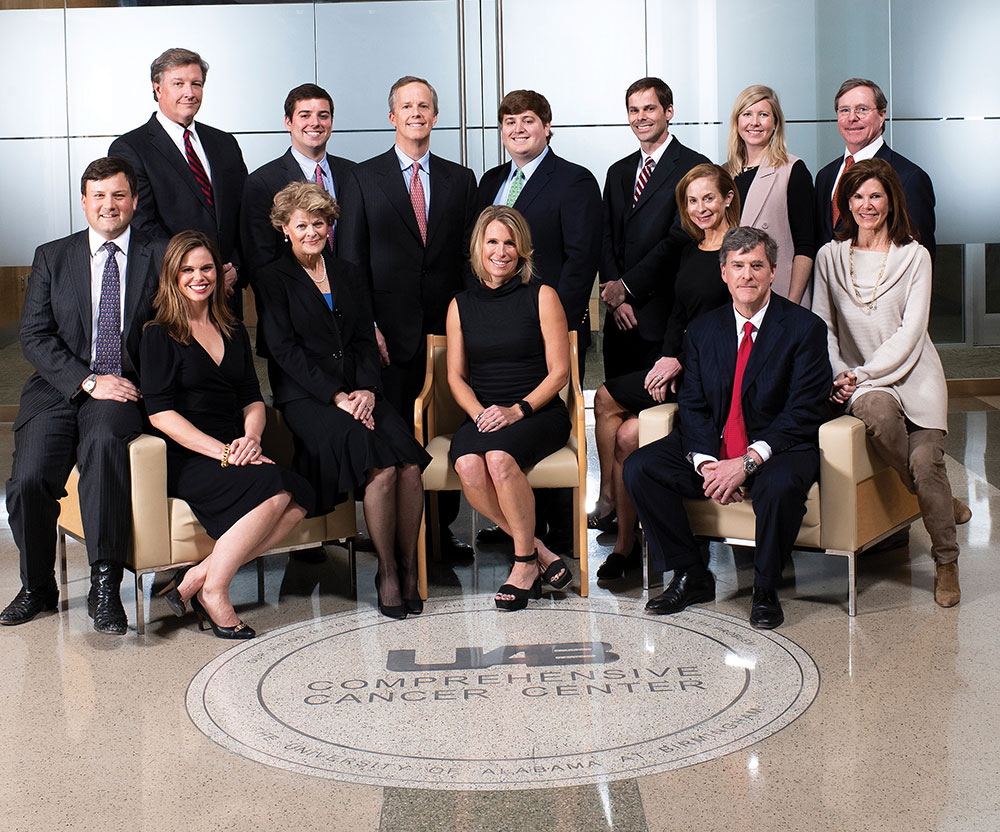 Members of the O'Neal family (above) visit the newly renamed O'Neal Comprehensive Cancer Center at UAB. Lalita Shevde-Samant, Ph.D. (below), a pathology professor and the center's associate director for education and training, welcomes Craft O'Neal and the visitors to her breast cancer research lab.
Members of the O'Neal family (above) visit the newly renamed O'Neal Comprehensive Cancer Center at UAB. Lalita Shevde-Samant, Ph.D. (below), a pathology professor and the center's associate director for education and training, welcomes Craft O'Neal and the visitors to her breast cancer research lab.
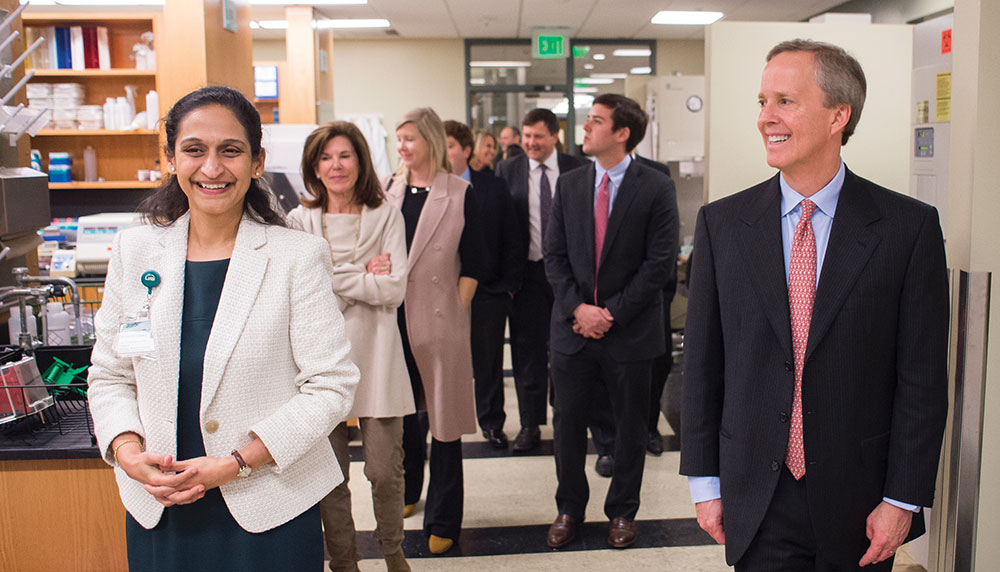
1. A boost for cancer breakthroughs
The next groundbreaking cancer treatment may come from UAB—a fact that draws patients from all over the country. They know that advances in molecular biology and preclinical testing have increased the chances that promising new drugs will work. So they seek to become one of the 500 new cancer patients enrolled in UAB clinical trials each year.
Soon more patients will have access to more new treatments now that Birmingham-based O’Neal Industries and its shareholders have donated $30 million—the largest single gift in UAB’s history—to turbocharge transformational cancer research, patient care, education, and prevention. That means the the renamed O'Neal Comprehensive Cancer Center at UAB also will have resources to recruit more of the best cancer scientists and clinicians, attract additional federal research grants, and pursue new cancer-fighting collaborations with biotechnology companies.
“We see this gift as an opportunity to give back in a meaningful way to a cause that is important to everyone,” says Craft O’Neal, chairman and CEO of O’Neal Industries. “We hope the gift will be used in ways that will yield the greatest results, accelerating progress in research, treatment, and prevention of cancer, and ultimately eliminate cancer as a major public health problem.”
The impact will reverberate throughout the Cancer Center’s research, patient care, and outreach networks that span Alabama and the Southeast. UAB is the only National Cancer Institute-designated comprehensive cancer center in a four-state region. “This gift will enhance the profile and impact of the cancer center as a premier national destination for those working to end cancer and those fighting a personal battle with the disease,” says Selwyn Vickers, M.D., senior vice president and the James C. Lee, Jr., Endowed Chair for the Dean of the School of Medicine. “It will have lifesaving results that can serve as a catalyst for further philanthropic investment, and we are grateful to O'Neal Industries for their leadership in the fight to end cancer.”
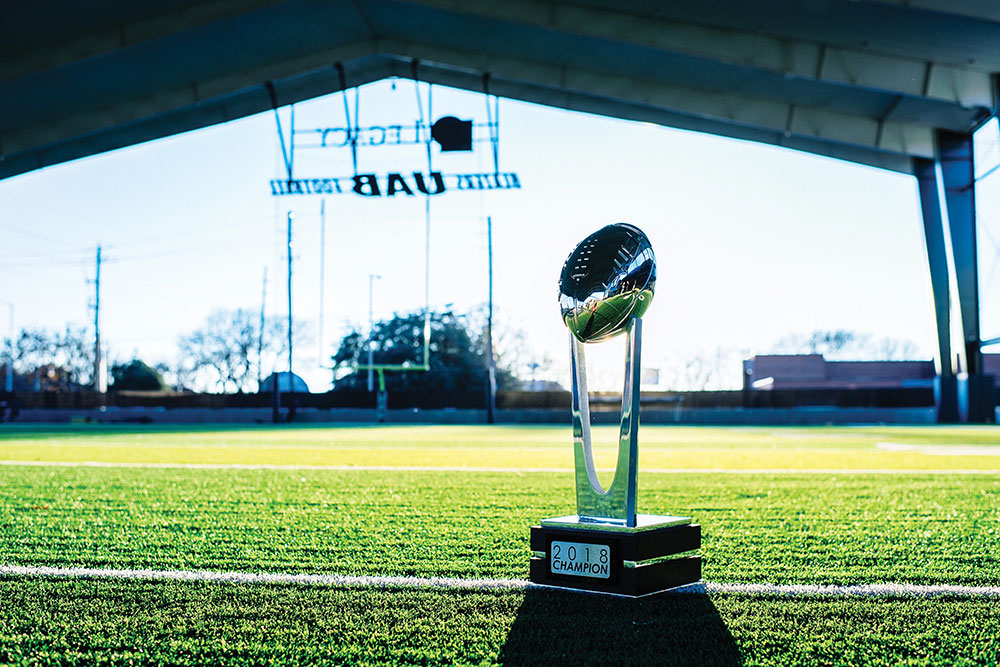 The 2018 Conference USA football championship trophy at Legacy Pavilion
The 2018 Conference USA football championship trophy at Legacy Pavilion
2. Blazer victories
The cheering hasn’t stopped following a banner year for Blazer athletics. Women’s basketball won its first Conference USA championship and scored a program record for most victories in a season. Bowling competed in its first-ever national championship. And football racked up a record number of wins, a C-USA championship, a win at the Cheribundi Boca Raton Bowl, a top-25 ranking, and the Eddie Robinson National Coach of the Year award for Head Coach Bill Clark.
But UAB coaches and student-athletes began feeling like winners long before the final buzzers thanks to record contributions. Athletics has received more than $40 million from alumni, students, civic and business leaders, and fans—including a 5-year-old Ohio boy who contributed his $1 allowance—since the Campaign's public phase began.
That support has fueled success on the field and on the court. It built the Football Operations Center and Legacy Pavilion, BBVA Compass Field for men’s and women’s soccer, and—coming soon—a competition-ready track and field venue and a five-court beach volleyball complex. A new locker room for women’s basketball, made possible by Bill Tevendale and his late wife, Jackie, and Lois Luther, “was a big piece of the puzzle in building a championship program,” says Head Coach Randy Norton. “It gives the team a sense of pride.”
The added support and new facilities give UAB coaches an edge in training their student-athletes—and in recruiting the next generation of Blazer champions. “As a university, we’ve decided to be first class in everything we do,” says Clark, looking around at the Football Operations Center and Legacy Pavilion, “and this is a great example.”
All UAB units celebrated record-breaking giving during the Campaign. Here are some highlights:
$34M
Most given to UAB in a single month
$125M
Most raised in a single year
$100M
Raised each year of the Campaign's five-year public phase
148
Donors who gave more than $1M
3. World-changing opportunities
Hundreds of students are realizing their dreams—of attending college, studying overseas, and kick-starting their careers—with support from 211 new endowed scholarships and other donor-funded awards. For example, the Blazing the Way Scholarship Match Initiative is helping UAB attract and retain the brightest students. And the Education Abroad Scholarship Match Initiative is giving more students the chance to explore the world firsthand—an experience that profoundly impacts their lives and learning once they return home. Another scholarship program, created with a gift from Blue Cross Blue Shield of Alabama, will address a statewide shortage of primary care physicians by supporting medical students who will practice in rural Alabama communities.
4. Medications on the move
Right now, 15 promising drugs—targeting diseases such as Alzheimer’s, Parkinson’s, diabetes, and various cancers—are making their way through the Alabama Drug Discovery Alliance (ADDA) pipeline. A partnership between UAB and Southern Research, ADDA guides the development and testing of new drugs, with approval by the Food and Drug Administration as the ultimate goal. A gift from Dai-ichi Life Insurance Company and Protective Life Corporation has brought new energy to each stage of the process, bringing the hope of new treatments closer to reality.
5. What's in a name?
A “transformational” gift from Birmingham businessman Charles Collat and his late wife, Patsy, led to UAB’s first named school—the Collat School of Business. Their generosity “enables us to grow in our targeted areas of strategic excellence and impact the lives of thousands of students,” says Eric Jack, Ph.D., the school's dean and the Wells Fargo Endowed Chair in Business Administration. “It also raises our profile as one of the premier business schools in the Southeast and will benefit our beloved city and state for years to come.”
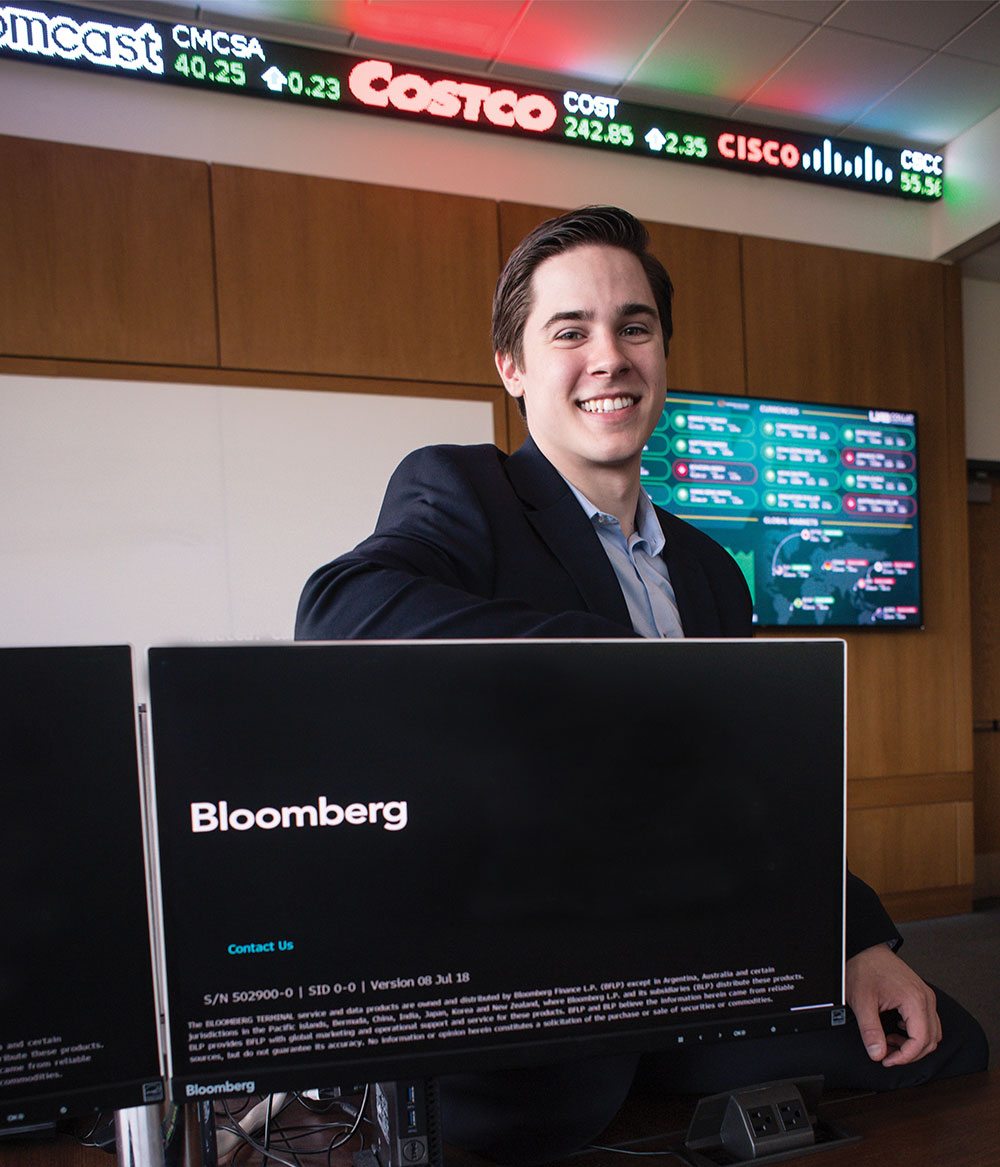 Jacob Irvin in the Chad Thomas Hagwood Finance Lab
Jacob Irvin in the Chad Thomas Hagwood Finance Lab
6. A new marketplace of ideas
The first time Jacob Irvin walked into the Chad Thomas Hagwood Finance Lab in the new home of the Collat School of Business, he realized he had seen it all before. The high-tech setup—complete with double-screened Bloomberg terminals and a stock ticker—resembles the offices of investment firms he has visited.
And that gives UAB students an edge when they enter the business world, says Irvin, a junior finance major from Dothan, Alabama. One example: The availability of the Bloomberg terminals means every student can gain experience performing stock market research and earn Bloomberg certification, an essential qualification for many business careers. That has impressed employers when he has sought internships, Irvin says. “These are things you expect to experience on the job, but we have them at UAB.”
Irvin is a frequent visitor to the lab as industrials portfolio manager for UAB’s Green and Gold Fund, the award-winning, student-managed investment portfolio that calls the space home. There, Irvin works alongside student analysts, using the Bloomberg database to research manufacturing-related stocks and create price-target models. From their findings, they make recommendations to the Green and Gold Fund about keeping or selling their current stocks or perhaps purchasing stock in an undervalued company.
Irvin is planning a career as a financial analyst in an investment firm. One day, he hopes to manage a hedge fund. He appreciates that Hagwood—a real estate management leader and UAB business alumnus—and other donors to the new building “are creating new investment minds who are going to contribute to the community. They know we’re the future business leaders,” Irvin says. “Their best interests and our best interests are aligned.”
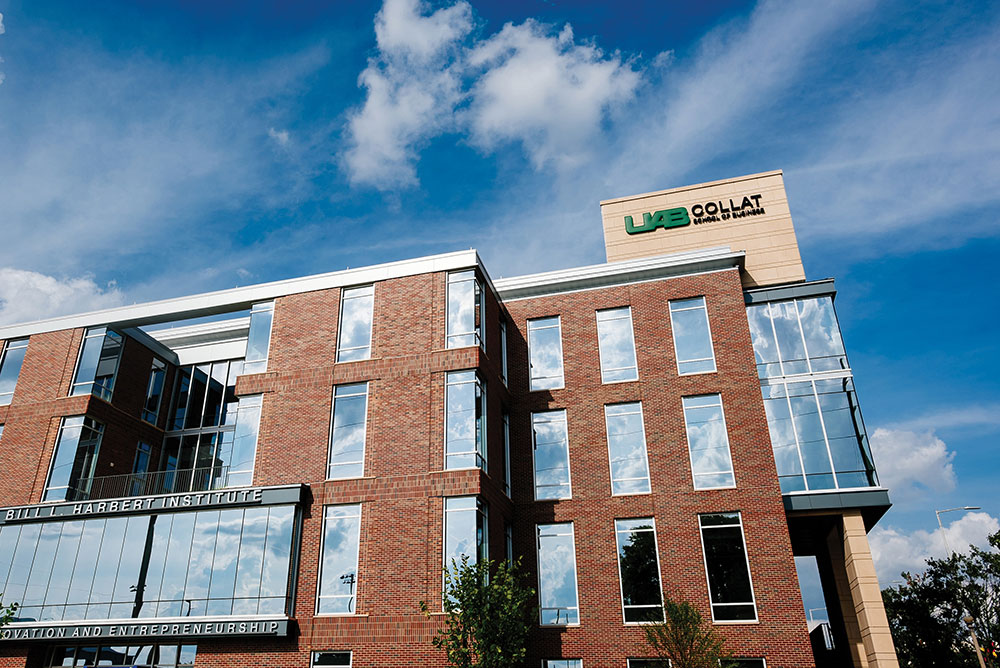 “This beautiful new building changes everything,” Jack says. “It heralds a new era of leadership in business education that will help drive innovation at UAB and in Birmingham for many years to come.” The 108,000-square-foot facility, constructed thanks to the generosity of more than 600 donors, houses both the Collat School of Business and the Bill L. Harbert Institute for Innovation and Entrepreneurship.
“This beautiful new building changes everything,” Jack says. “It heralds a new era of leadership in business education that will help drive innovation at UAB and in Birmingham for many years to come.” The 108,000-square-foot facility, constructed thanks to the generosity of more than 600 donors, houses both the Collat School of Business and the Bill L. Harbert Institute for Innovation and Entrepreneurship.
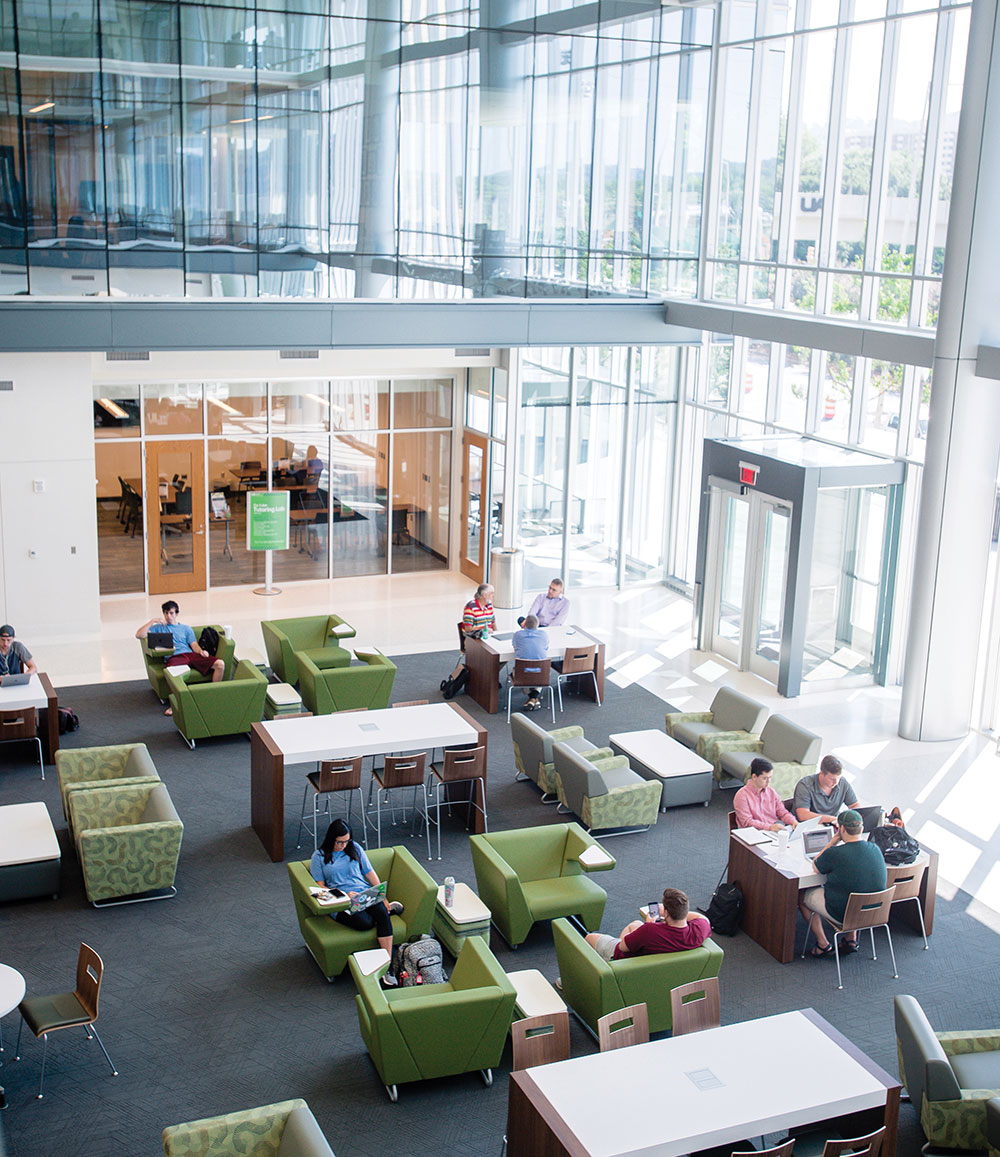 The bright, spacious facility is designed to inspire and grow business ideas, with classrooms for team-based learning , sales roleplaying rooms, an auditorium, a career center, and the Medical Properties Trust Commons — a soaring atrium where students can gather. “It’s breathtaking—way beyond my expectations,” Irvin says.
The bright, spacious facility is designed to inspire and grow business ideas, with classrooms for team-based learning , sales roleplaying rooms, an auditorium, a career center, and the Medical Properties Trust Commons — a soaring atrium where students can gather. “It’s breathtaking—way beyond my expectations,” Irvin says.
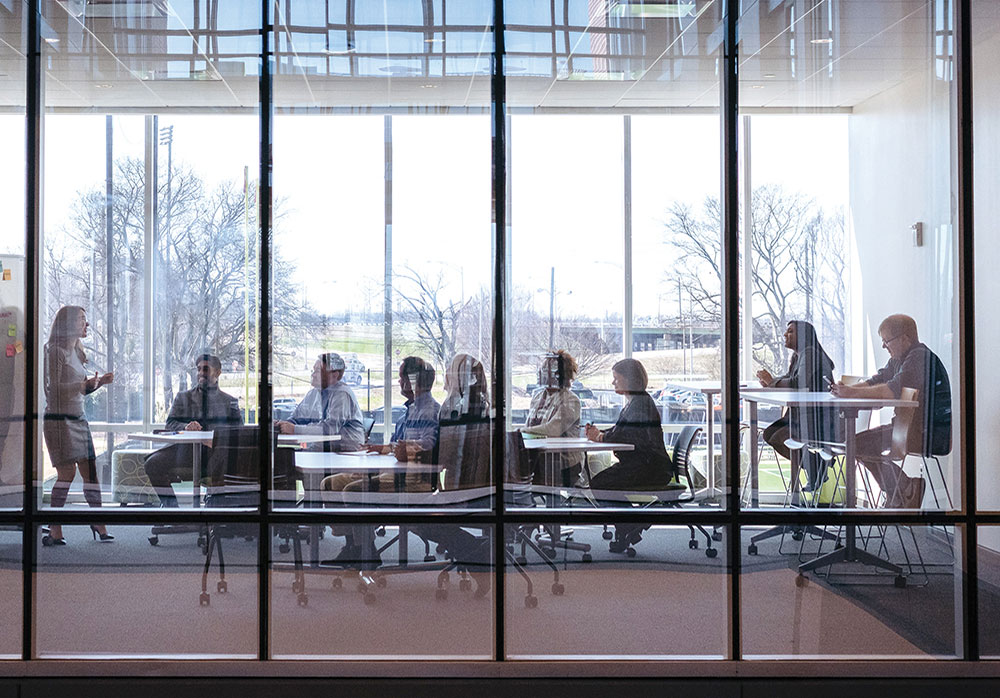 Along with the Bill L. Harbert Institute for Innovation and Entrepreneurship (pictured above), the building houses the Nielsen Innovation Lab, a flexible, collaborative space that generates big ideas from both current and future entrepreneurs. Students can join entrepreneurship clubs, take classes focused on innovation and business incubation, and work on their own start-ups. In addition, the Regions Institute for Financial Education cultivates financial literacy throughout the community and state. Supported by a gift from Regions Bank, the institute provides everyone, from school children to adults, with the knowledge and skills to make smart decisions about their money.
Along with the Bill L. Harbert Institute for Innovation and Entrepreneurship (pictured above), the building houses the Nielsen Innovation Lab, a flexible, collaborative space that generates big ideas from both current and future entrepreneurs. Students can join entrepreneurship clubs, take classes focused on innovation and business incubation, and work on their own start-ups. In addition, the Regions Institute for Financial Education cultivates financial literacy throughout the community and state. Supported by a gift from Regions Bank, the institute provides everyone, from school children to adults, with the knowledge and skills to make smart decisions about their money.
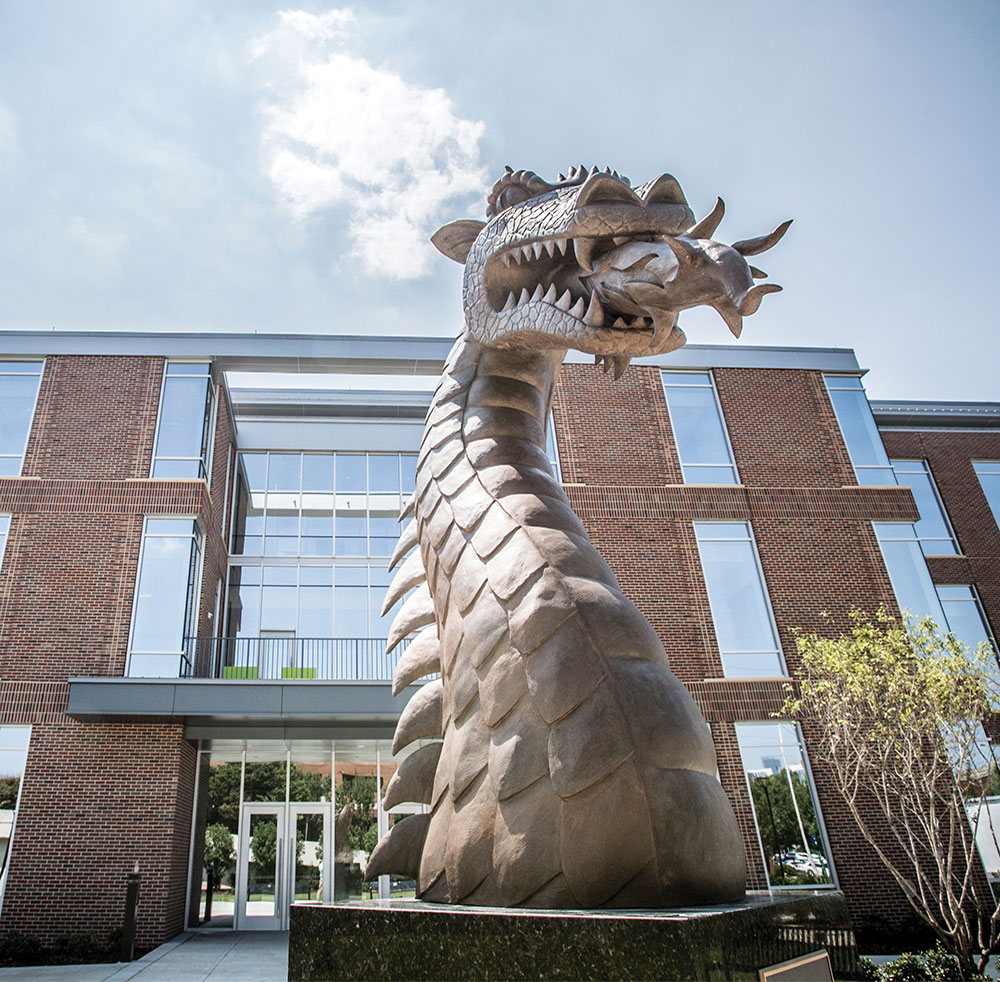 Blazer Pride Plaza welcomes visitors to the building. Its centerpiece, an eight-foot bronze Blaze statue sculpted by Birmingham artist Branko Medenica, is a gift from UAB business alumnus Ken Jackson. He hopes it serves as both an icon and inspiration for students.
Blazer Pride Plaza welcomes visitors to the building. Its centerpiece, an eight-foot bronze Blaze statue sculpted by Birmingham artist Branko Medenica, is a gift from UAB business alumnus Ken Jackson. He hopes it serves as both an icon and inspiration for students.
7. Genomic gateway
What happens inside the Altec Styslinger Genomic Medicine and Data Sciences Facility will help chart the future course of health care. The renovated space, made possible by a generous gift from the Altec Styslinger Foundation, will house researchers who will use advanced science and technology to seek cutting-edge therapies and pioneer precision medicine. The facility also will help UAB secure millions of dollars in additional research funding and create hundreds of new jobs.
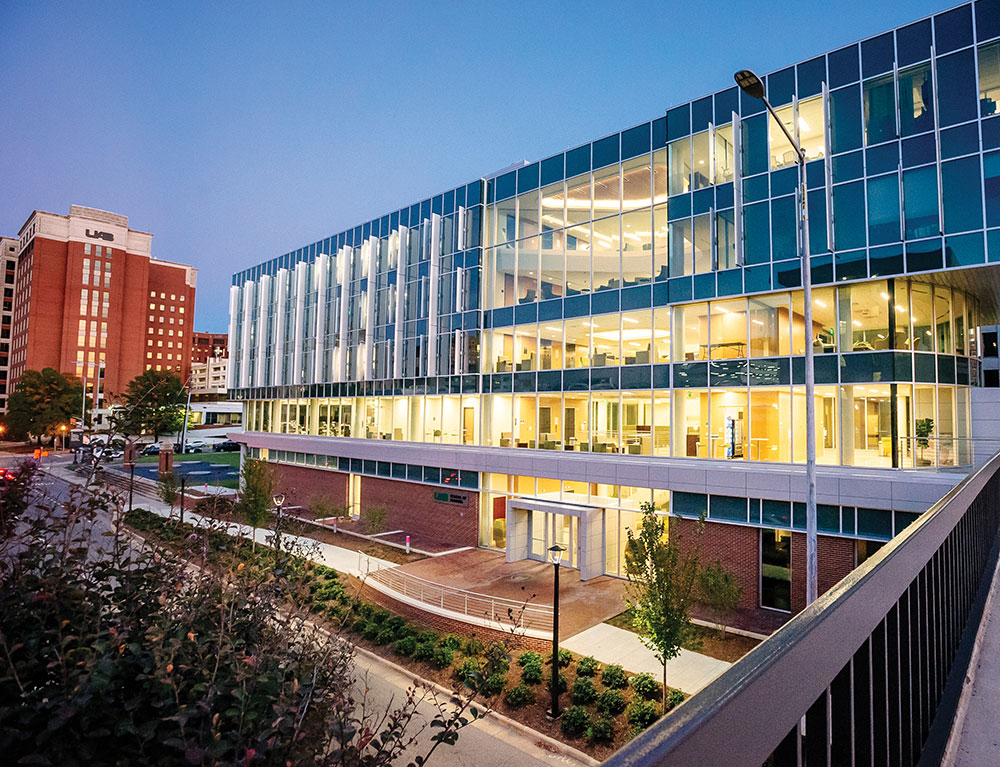 The expanded and renovated School of Nursing building
The expanded and renovated School of Nursing building
8. Care that goes everywhere
Behind its gleaming façade, the expanded and renovated School of Nursing building offers a view to the future of health care. High-tech simulation labs help students cultivate their skills providing care in lifelike settings—among them a working operating room, a pediatric suite, and a patient’s home. Advanced technology throughout the 72,000-square-foot facility enables UAB nursing leaders to share innovative ideas with students and colleagues worldwide. The same equipment also expands the reach of UAB research in telehealth, which can connect medically underserved patients in Alabama’s rural and urban areas with the care they need.
In fact, patients everywhere may benefit from the $32-million project, which was supported by School of Nursing alumni, community supporters, and faculty. The facility “enables us to prepare the next generation of compassionate and highly competent nurses to deliver expert, innovative care; conduct research that will lead to new standards of care; and generate better health care solutions for all population groups throughout our city, state, and world,” says Doreen Harper, Ph.D., R.N., the Fay B. Ireland Endowed Chair for the Dean of the School of Nursing.
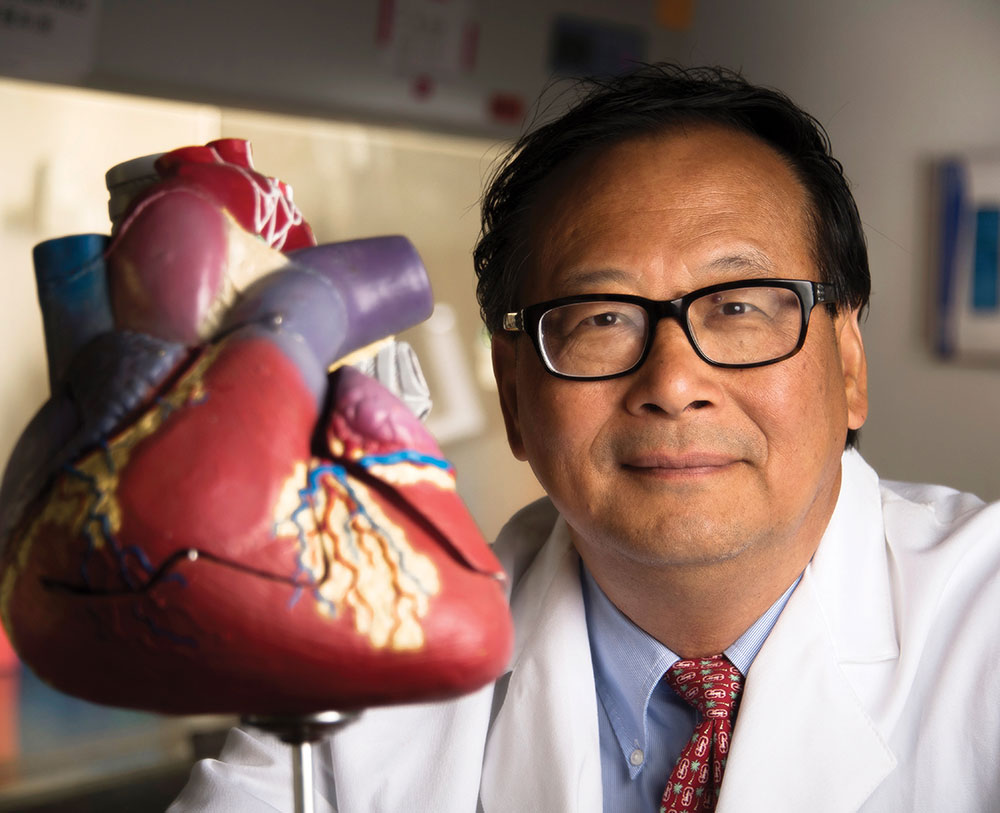 Jianyi "Jay" Zhang
Jianyi "Jay" Zhang
9. Help for broken hearts
Surviving a heart attack is the first step on a long road of recovery. Heart muscle cells may be injured or dead, which can put patients at risk for heart failure.
Biomedical engineering chair Jianyi “Jay” Zhang, M.D., Ph.D., is working on a way to patch up those problems—by creating actual human cardiac muscle patches that attach to a heart’s damaged tissue, helping it regenerate muscle and heal injured cells. Zhang has spent decades trying to prevent heart failure following an attack, and a gift to UAB—which created the T. Michael and Gillian Goodrich Endowed Chair of Engineering Leadership—brought him to Birmingham in 2015. Now his lifesaving patch technology could be in clinical trials by 2023, he says. In studies with animal models, one version of the patch—1.57 by 0.79 inches in size and nearly as thick as a dime—significantly improved heart attack injury and prevented arrhythmia, a serious complication of other treatment approaches.
Along with supporting Zhang’s breakthroughs, the Goodrich endowment has led to other successes for the Department of Biomedical Engineering, a collaboration between the School of Engineering and School of Medicine. In bringing Zhang to UAB, it created new laboratory research opportunities for graduate students and postdoctoral fellows. It also paved the way for Zhang to win the Ruth L. Kirschstein National Research Service Awards Institutional Research Training Grant. The $750,000 grant from the National Institutes of Health (NIH), which supports up to four predoctoral students each year for five years, is the first of its kind to be awarded to an engineering department in Alabama. Participating in this highly selective program will help students visit labs across the country and propel them toward leadership in the biomedical engineering field, Zhang says.
The investment in UAB’s cardiovascular tissue engineering research has boosted UAB’s national and international reputation. Since 2016, the department has ranked among the top five joint biomedical engineering departments nationally in NIH funding. UAB also has hosted the annual NIH-sponsored Cardiovascular Bioengineering Symposium, which attracts top leaders in the field, since its inception in 2017.
One of those leaders is Philippe Menasché, M.D., Ph.D., whom Zhang calls a pioneer in cardiac cell therapy for more than 20 years. His cardiac muscle patch recently completed its first clinical trial. Menasché "is the father of it all,” Zhang says. “Because of our growing reputation, we were able to bring him to our faculty.”
“Taking care of heart failure in the world is a trillion-dollar business,” Zhang says. “If we are successful, then we will make an impact on many lives.”
10. Bringing the best to Birmingham
Campaign donors helped fund 106 endowed chairs, professorships, and scholars, enabling UAB to recruit and retain renowned leaders in teaching, research, and clinical care. Some of the new positions will boost UAB’s expertise in emerging fields including precision medicine, entrepreneurship, health economics, and physician wellness.
11. New hope against challenging diseases
Millions of people may one day find relief from diabetes, Alzheimer’s disease—even some forms of depression—thanks to the many donors accelerating UAB research toward breakthrough treatments. Already, UAB’s Comprehensive Diabetes Center has discovered that verapamil, a common blood pressure medication, can help some patients with type 1 diabetes produce higher levels of their own insulin, limiting their need for injected insulin. UAB psychiatry researchers are investigating drugs that could provide a fast, effective option for patients with difficult-to-treat depression and thoughts of suicide. And UAB’s Alzheimer’s Disease Center is testing more than 10 potential new therapies for the disease and related neurogenerative disorders.
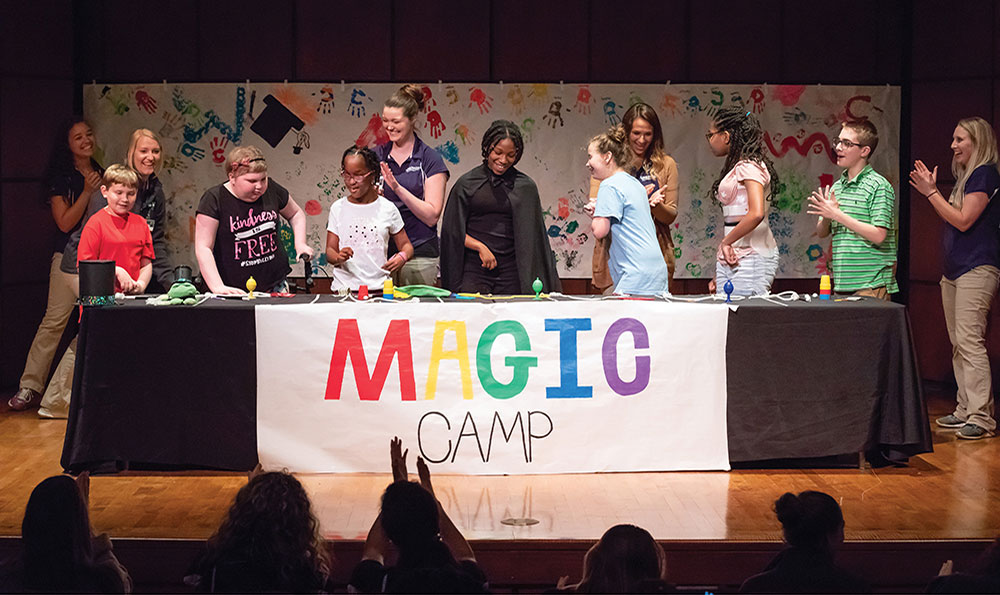 Magic Camp participants (above) perform their tricks. Illusionist Kevin Spencer (below) shows OT students how to make therapy fun.
Magic Camp participants (above) perform their tricks. Illusionist Kevin Spencer (below) shows OT students how to make therapy fun.
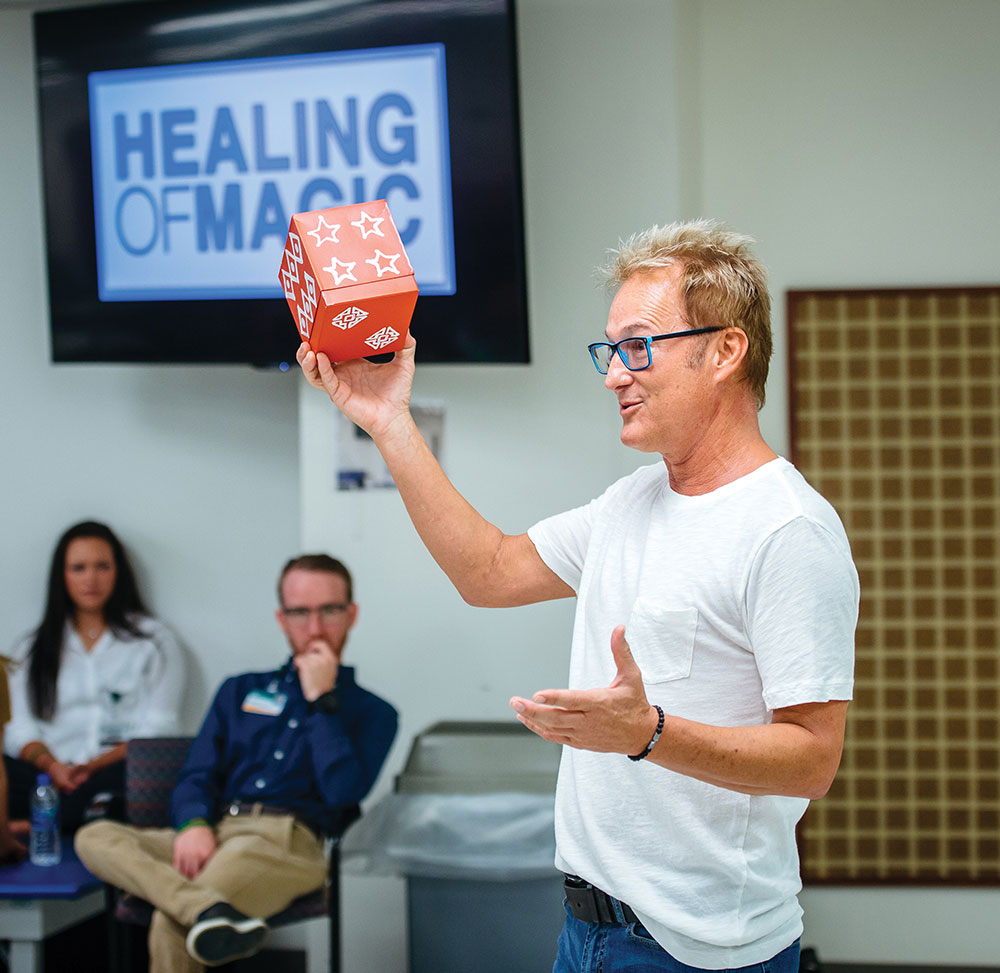
12. A creative approach to healing
Waving their wands, the children in last summer’s Magic Camp at UAB’s Alys Stephens Performing Arts Center performed tricks that amused and amazed. But real magic was at work there. In learning to perform illusions, the participants—children with some form of physical limitation caused by cerebral palsy, hemiplegia, or another cognitive condition—benefited from a new, fun approach to therapy for developmental challenges.
A gift from the Monday Morning Quarterback Club and donors William Mann and Sandra Zahradka Mann to UAB’s Institute for Arts in Medicine (AIM) set the magic in motion. AIM, a partnership between UAB Medicine and the Alys Stephens Center, promotes a healing environment for patients and families through creativity. AIM’s eight artists-in-residence in UAB Hospital—including painters, poets, musicians, dancers, and storytellers—complement clinical efforts by addressing the needs of the mind, body, and spirit.
For Magic Camp, AIM collaborated with the UAB School of Medicine, Children’s of Alabama, and the UAB School of Health Professions Department of Occupational Therapy (OT). First-year OT students put into practice techniques they learned from visiting illusionist Kevin Spencer, a leader in the use of magic for physical and psychosocial rehabilitation.
For many of the young patients, therapy means practicing physical and mental tasks repeatedly—just like learning to perform a magic trick. The new approach “mesmerizes” the children, says Gavin Jenkins, Ph.D., chair of the Department of Occupational Therapy. “They’re so engaged by the tricks that they don’t realize it’s therapy.” Now Jenkins and the OT students are reviewing research data from tests with the campers to gauge the impact.
“Magic Camp was a joyful thing,” says Kimberly Kirklin, AIM director. “The children were nervous and uncertain at first, but within a few days they were jumping up to share tricks with the group. Their confidence level increased, even when they worked with their weaker hand or side.
“At the end, it wasn’t about their physical limitation,” Kirklin says. “It was about them being on stage and performing like a magician. That was wonderful to see.”
13. One-of-a-kind care
Precision medicine “is ultra-individualized care” that uses genomic sequencing, informatics databases, and other technologies “to get the right drug to the right patient at the right time,” says Matt Might, Ph.D., the Hugh Kaul Endowed Chair of Personalized Medicine. He leads UAB’s Hugh Kaul Precision Medicine Institute, which is helping UAB race to the forefront of this emerging field, particularly in treating rare diseases and cancer. “We’ve established a blueprint for using precision medicine to go from disease discovery to therapeutic identification within one year,” Might says. “We’re scaling it up in a big way.” A contribution from the Hugh Kaul Foundation established both the endowed chair and the institute.
14. State of innovation
A robust, technology-based economy is taking root in Birmingham and Alabama, fueled by the growth of UAB’s Bill L. Harbert Institute for Innovation and Entrepreneurship. With support from the Joy and Bill Harbert Foundation, the institute helps UAB researchers translate their ideas and discoveries into new products—and new tech start-up companies based in Birmingham. The Harbert gift even provides seed funding to help launch some the most exciting projects. The foundation also contributed to the construction of the institute’s new home on University Boulevard.
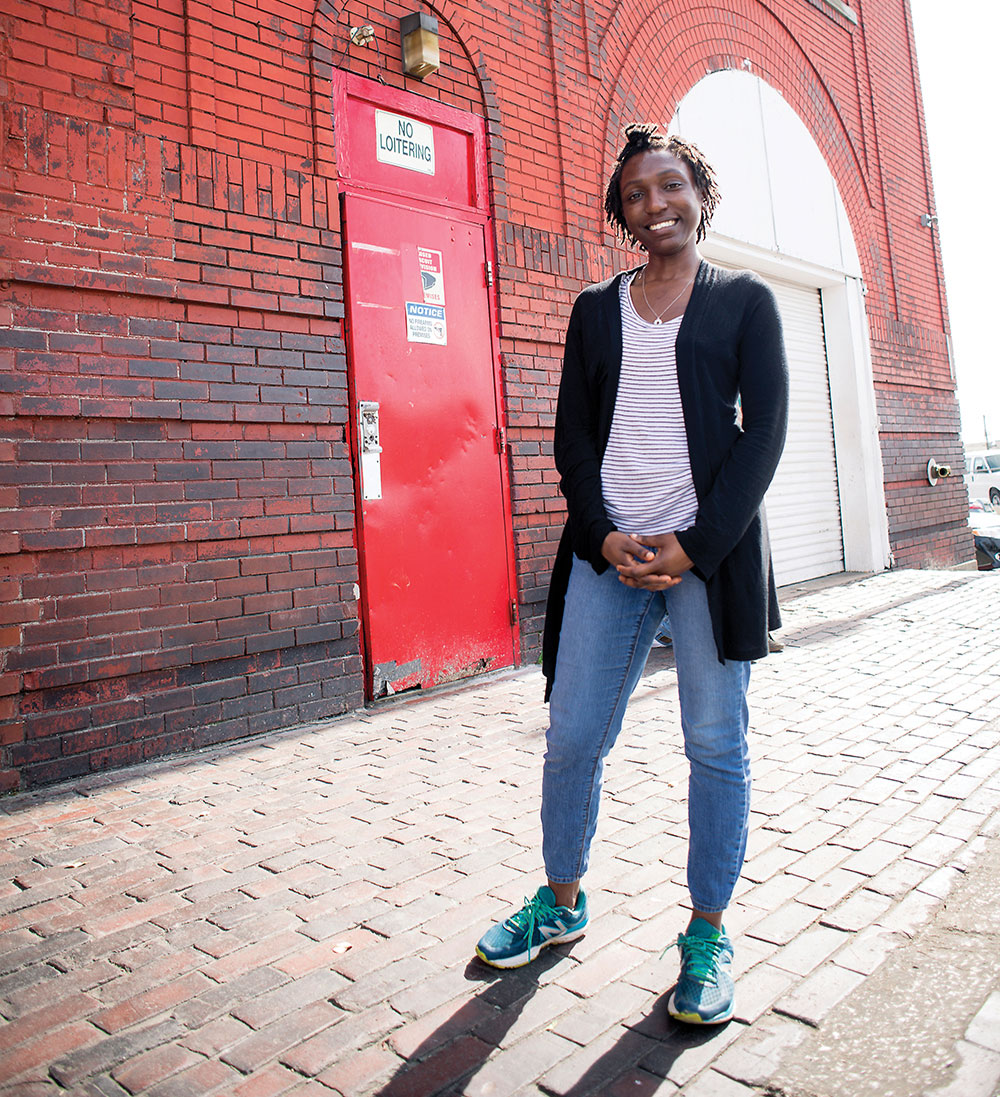 Stephanie Diei at the Firehouse Shelter
Stephanie Diei at the Firehouse Shelter
15. The next expert in mental health care
Stephanie Diei loves research that brings her face to face with people who could benefit from it. A UAB Honors College student pursuing a biomedical sciences major in the School of Health Professions, Diei has studied smoking cessation among cancer patients and trained individuals to use naloxone for treating opioid overdoses. “I like being able to see the direct impacts on patients’ lives,” says the Chicago native.
A team research project exploring health disparities among the local homeless population sparked a passion that left Diei wanting to learn more about mental health and homelessness. Supported by a UAB Honors College Presidential Summer Fellowship and an Honors Enrichment Fund award—made possible by donations from Honors College alumni, parents, faculty, staff, and friends—Diei was able to pursue new opportunities for discovery.
Diei partnered with Birmingham’s Firehouse Shelter, which serves men who are homeless, to give twice-weekly presentations on depression, anxiety, post-traumatic stress disorder, substance abuse, and other issues related to mental well-being. She also led group discussions and taught self-coping techniques. “These conversations sparked motivation for many to not give up hope,” she says, “and showed them that mental illness can affect anyone.”
The funding then gave Diei the opportunity to present her findings about mental health and the homeless community at the National Conference on Undergraduate Research in Edmond, Oklahoma. She also attended the Annual Biomedical Research Conference for Minority Students in Phoenix, Arizona. With these experiences under her belt, Diei plans to pursue a Ph.D. and expand her research into mental illness—this time within urban African-American communities.
Diei appreciates how UAB’s opportunities and the community’s generosity have combined to help her explore her interests and make a positive impact. “This experience has enabled me to grow, not only as a student but also as a young adult emerging into the real world,” she says.
Published May 2019
 Members of the O'Neal family (above) visit the newly renamed O'Neal Comprehensive Cancer Center at UAB. Lalita Shevde-Samant, Ph.D. (below), a pathology professor and the center's associate director for education and training, welcomes Craft O'Neal and the visitors to her breast cancer research lab.
Members of the O'Neal family (above) visit the newly renamed O'Neal Comprehensive Cancer Center at UAB. Lalita Shevde-Samant, Ph.D. (below), a pathology professor and the center's associate director for education and training, welcomes Craft O'Neal and the visitors to her breast cancer research lab.
 The 2018 Conference USA football championship trophy at Legacy Pavilion
The 2018 Conference USA football championship trophy at Legacy Pavilion Jacob Irvin in the Chad Thomas Hagwood Finance Lab
Jacob Irvin in the Chad Thomas Hagwood Finance Lab “This beautiful new building changes everything,” Jack says. “It heralds a new era of leadership in business education that will help drive innovation at UAB and in Birmingham for many years to come.” The 108,000-square-foot facility, constructed thanks to the generosity of more than 600 donors, houses both the Collat School of Business and the Bill L. Harbert Institute for Innovation and Entrepreneurship.
“This beautiful new building changes everything,” Jack says. “It heralds a new era of leadership in business education that will help drive innovation at UAB and in Birmingham for many years to come.” The 108,000-square-foot facility, constructed thanks to the generosity of more than 600 donors, houses both the Collat School of Business and the Bill L. Harbert Institute for Innovation and Entrepreneurship. The bright, spacious facility is designed to inspire and grow business ideas, with classrooms for team-based learning , sales roleplaying rooms, an auditorium, a career center, and the Medical Properties Trust Commons — a soaring atrium where students can gather. “It’s breathtaking—way beyond my expectations,” Irvin says.
The bright, spacious facility is designed to inspire and grow business ideas, with classrooms for team-based learning , sales roleplaying rooms, an auditorium, a career center, and the Medical Properties Trust Commons — a soaring atrium where students can gather. “It’s breathtaking—way beyond my expectations,” Irvin says. Along with the Bill L. Harbert Institute for Innovation and Entrepreneurship (pictured above), the building houses the Nielsen Innovation Lab, a flexible, collaborative space that generates big ideas from both current and future entrepreneurs. Students can join entrepreneurship clubs, take classes focused on innovation and business incubation, and work on their own start-ups. In addition, the Regions Institute for Financial Education cultivates financial literacy throughout the community and state. Supported by a gift from Regions Bank, the institute provides everyone, from school children to adults, with the knowledge and skills to make smart decisions about their money.
Along with the Bill L. Harbert Institute for Innovation and Entrepreneurship (pictured above), the building houses the Nielsen Innovation Lab, a flexible, collaborative space that generates big ideas from both current and future entrepreneurs. Students can join entrepreneurship clubs, take classes focused on innovation and business incubation, and work on their own start-ups. In addition, the Regions Institute for Financial Education cultivates financial literacy throughout the community and state. Supported by a gift from Regions Bank, the institute provides everyone, from school children to adults, with the knowledge and skills to make smart decisions about their money. Blazer Pride Plaza welcomes visitors to the building. Its centerpiece, an eight-foot bronze Blaze statue sculpted by Birmingham artist Branko Medenica, is a gift from UAB business alumnus Ken Jackson. He hopes it serves as both an icon and inspiration for students.
Blazer Pride Plaza welcomes visitors to the building. Its centerpiece, an eight-foot bronze Blaze statue sculpted by Birmingham artist Branko Medenica, is a gift from UAB business alumnus Ken Jackson. He hopes it serves as both an icon and inspiration for students. The expanded and renovated School of Nursing building
The expanded and renovated School of Nursing building Jianyi "Jay" Zhang
Jianyi "Jay" Zhang Magic Camp participants (above) perform their tricks. Illusionist Kevin Spencer (below) shows OT students how to make therapy fun.
Magic Camp participants (above) perform their tricks. Illusionist Kevin Spencer (below) shows OT students how to make therapy fun.
 Stephanie Diei at the Firehouse Shelter
Stephanie Diei at the Firehouse Shelter

